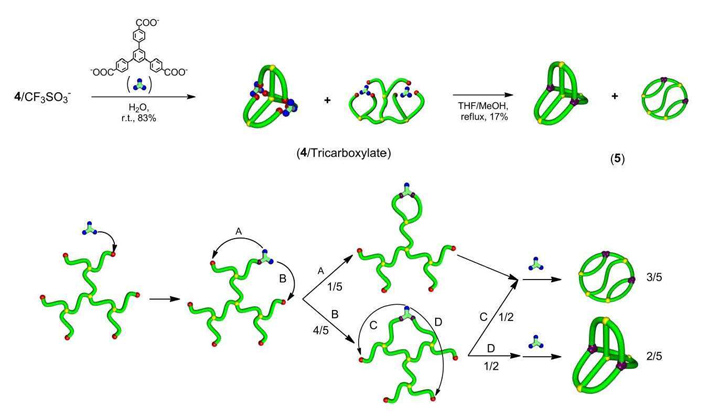Spot light on tailor made multicyclic type of polymers

Fig: (UPPER): The researchers developed a method combining electrostatic self-assembly and covalent fixation to construct two geometries of triply fused tetracyclic polymer labelled (5).The products were made from molecules with several branches and two negatively charged groups. (LOWER): A scheme showing random combination of the end groups during covalent conversion to form the two types of triply fused tetracyclic polymer. Copyright : © From cited paper, 2014
Tokyo Tech scientists synthesize multicyclic type of polymers for the first time offering insights for tailoring polymer properties as well as the mathematics of complex geometries.
Polymers come with a range of properties dictated by their chemical composition and geometrical arrangement. Yasuyuki Tezuka and his team at Tokyo Institute of Technology have now applied an approach to synthesise a new type of multicyclic polymer geometry.
“This additional step will give a library of architectures to allow systematic studies of what properties derive from what structures,” explains Tezuka, adding, “Mathematicians who study these complex geometries are also interested to know they can be made at the nanoscale.”
Rings have very different properties to linear polymers, in particular when considering dynamic rather than static characteristics, such as diffusion. Tezuka adds that these differences are amplified when moving from single ring or linear chains to self-assembled structures such as micelles — pompom-ball-like structures of aggregated linear chains.
However the Tokyo Tech researchers were motivated more by the geometry itself than the possible applications. While mathematicians are interested because these structures have not been realized before, the geometry studies also provide insights for chemists. “You may have two complex structures that are so-called isomers, that is, they are from identical starting materials like brothers,” explains Tezuka. “The geometry tells us that the two constructions are isomers.”
In fact the geometry of the polymer, known as K3,3, has been a popular field of study for mathematicians in graph theory. The geometry comprises four rings (tetracyclic) fused three ways (triply fused) with an inherently non-planar structure.
The team's approach combines fixation by covalent bonding with electrostatic self-assembly, which involves negatively and positively charged molecular units coming together, as in a salt. Salts should be insoluble in organic solvents, “But in polymer synthesis the situation is different,” explains Tezuka. “The polymer is a long chain, and very hydrophobic and organically soluble. So if you add a little salt it is still soluble.”
While a number of multicyclic polymers have been achieved using this approach since it was developed by Tezuka and his colleagues ten years ago, it is not so easy when several charged units are involved. The team succeeded by developing special highly branched and symmetric molecular chemicals and adding ionic groups and polymer chain ends. “The result came from trial and error and then we optimised the chemistry,” says Tezuka.
He emphasises the contribution of a particularly dedicated student, Takuya Suzuki, who successfully exploited the difference in size of the component molecules to separate the two final products of these reactions: the non-planar K3,3 polymer and another tetracyclic triply fused molecule with a ladder-type geometry. “I personally didn't believe they could be separated but he found the conditions to separate the two components completely,” says Tezuka. “It's a very nice example of Japanese craftsmanship!”
The team are now in collaboration with simulation specialists with the aim of generalizing the approach. “This paper is the basic proof of concept,” says Tezuka. “There are many other structures that are not easy to make at the nanoscale.”
Further information
Professor Yasuyuki Tezuka
Department of Organic and Polymeric Materials
Tel +81-3-5734-2498 FAX +81-3-5734-2876
E-mail ytezuka@o.cc.titech.ac.jp
Tezuka Laboratory: http://www.op.titech.ac.jp/lab/tezuka/ytsite/sub0e.html
Further general information
Yukiko Tokida, Miwako Kato
Center for Public Affairs and Communications, Tokyo Institute of Technology
2-12-1, Ookayama, Meguro-ku, Tokyo 152-8550, Japan
E-mail: publication@jim.titech.ac.jp
URL: http://www.titech.ac.jp/english/
Tel: +81-3-5734-2975 Fax: +81-3-5734-3661
About Tokyo Institute of Technology
As one of Japan’s top universities, Tokyo Institute of Technology seeks to contribute to civilization, peace and prosperity in the world, and aims at developing global human capabilities par excellence through pioneering research and education in science and technology, including industrial and social management. To achieve this mission, we have an eye on educating highly moral students to acquire not only scientific expertise but also expertise in the liberal arts, and a balanced knowledge of the social sciences and humanities, all while researching deeply from basics to practice with academic mastery. Through these activities, we wish to contribute to global sustainability of the natural world and the support of human life.
Website: http://www.titech.ac.jp/english/
Associated links
Journal information
Authors: Takuya Suzuki , Takuya Yamamoto , and Yasuyuki Tezuka
Title of original paper: Constructing a macromolecular K3,3 Graph through electrostatic self-assembly and covalent fixation with a dendritic polymer precursor.
Journal, volume, pages and year: Journal of the American Chemical Society, 136(28), 10148-10155 (2014)
DOI: 10.1021/ja504891x
Media Contact
All latest news from the category: Life Sciences and Chemistry
Articles and reports from the Life Sciences and chemistry area deal with applied and basic research into modern biology, chemistry and human medicine.
Valuable information can be found on a range of life sciences fields including bacteriology, biochemistry, bionics, bioinformatics, biophysics, biotechnology, genetics, geobotany, human biology, marine biology, microbiology, molecular biology, cellular biology, zoology, bioinorganic chemistry, microchemistry and environmental chemistry.
Newest articles

Silicon Carbide Innovation Alliance to drive industrial-scale semiconductor work
Known for its ability to withstand extreme environments and high voltages, silicon carbide (SiC) is a semiconducting material made up of silicon and carbon atoms arranged into crystals that is…

New SPECT/CT technique shows impressive biomarker identification
…offers increased access for prostate cancer patients. A novel SPECT/CT acquisition method can accurately detect radiopharmaceutical biodistribution in a convenient manner for prostate cancer patients, opening the door for more…

How 3D printers can give robots a soft touch
Soft skin coverings and touch sensors have emerged as a promising feature for robots that are both safer and more intuitive for human interaction, but they are expensive and difficult…





















